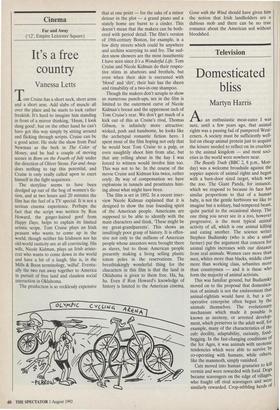Television
Domesticated bliss
Martyn Harris
As an enthusiastic meat-eater I was sure, until a few years ago, that animal rights was a passing fad of pampered West- erners. A society must be sufficiently well- fed on cheap animal protein just to acquire the leisure needed to reflect on its cruelties to the animal kingdom — and most soci- eties in the world were nowhere near.
The Beastly Truth (BBC 2, 8 p.m., Mon- day) was a welcome broadside against the soppier aspects of animal rights and began with a barn-door sized target, which was the zoo. The Giant Panda, for instance, which we respond to because its face has similar proportions to that of a human baby, is not the gentle herbivore we like to imagine but a solitary, bad-tempered beast, quite partial to the occasional sheep. The one thing you never see in a zoo, however progressive, is the most typical animal activity of all, which is one animal killing and eating another. The science writer Stephen Budiansky (who is also a small farmer) put the argument that concern for animal rights increases with our distance from real animals. Women care more than men, whites more than blacks, middle class more than working class, urbanites more than countrymen — and it is these who form the majority of animal activists.
This was familiar ground, but Budiansky moved on to the proposal that domestica- tion of animals is not the enslavement that animal-rightists would have it, but a co- operative enterprise often begun by the animals themselves. The evolutionary mechanism which made it possible Is known as neoteny, or arrested develop- ment, which preserves in the adult wolf, for example, many of the characteristics of the cub: docility, adaptability, curiosity, food- begging. In the fast-changing conditions of the Ice Ages, it was animals with neotenic tendencies which were able to survive by co-operating with humans, while others, like the mammoth, simply vanished. Cats moved into human granaries to kill vermin and were rewarded with food. Dogs became scavengers on the edge of villages, who fought off rival scavengers and were similarly rewarded. Crop-nibbling herds of goats were tolerated in exchange for pro- viding the odd dead goat. Domestication was a survival strategy, and a very success- ful one for a creature like the horse, which was almost extinct at the end of the last Ice Age and now exists in great numbers, and conditions of extraordinary luxury, in every continent on earth. From a moral point of view this enslavement might be seen as a disgusting fact, but the Blind Watchmaker of the DNA helix knows nothing of morali- ty and enslavement — only survival.
And yet, and yet. . . . The horse, breed- ing ewe, milk cow might enjoy pleasanter lives than they ever could in the wild which they are, in any case, completely unable to return to. But nobody who has ever entered the noonday darkness and hellish noise of a modern piggery could imagine these were fortunate creatures, or that DNA survival could justify the condi- tions in which we keep them. They would, as the animal activists insist, be better off dead, as would all the smoking beagles and shampooed bunny-rabbits.
Animals may have entered a voluntary contract 10,000 years ago, and some may still be benefiting, but we have rewritten the terms in the meantime, and acquired more scruples, not all of them idiotic or sentimental. Hardly a child of my acquain- tance has not dallied with vegetarianism, and there is scarcely a civilised adult who is not a little squeamish about veal and bat- tery eggs. The Beastly Truth was a usefully reactionary programme, but I still wouldn't be surprised if in 50 years' time a dripping steak had become as unacceptable to my grandchildren as the Elizabethan habit of eating songbirds.



















































 Previous page
Previous page